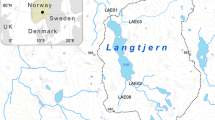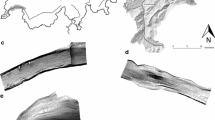Abstract
Dilution of the water chemistry caused by reduced acidification has lately received increased attention, both in Europe and North America. There has also been a declining trend in the supply of sea salts. Several studies have predicted detrimental effects on aquatic life due to dilution. A population of brook trout living in River Hunnedal in southwestern Norway was studied for 14 years (2006–2019). Despite acceptable water chemistry with respect to pH and inorganic Al, limited reproduction was found. With median conductivity, Ca and Na of 7.1–8.6 μScm−1, and 0.17–0.19 and 0.9–1.0 mgL−1, respectively, the water at the study sites was found to be extremely dilute. We detected a significant positive effect of Na on the densities of brook trout fry, while a less distinct effect of Ca was found. However, due to the correlation between Ca and Na we cannot conclude that Ca is unimportant. For all samplings without catch of fry (n = 13), Na was 0.86 ± 0.15 mgL−1, suggesting a critical limit for Na slightly below 1 mgL−1. We suggest that the reproduction of brook trout was restricted by the highly dilute water and the subsequent scarcity of essential ions.



Similar content being viewed by others
References
Bohlin, T., Hamrin, S., Heggberget, T. G., Rasmussen, G., & Saltveit, S. J. (1989). Electrofishing—Theory and practice with special emphasis on salmonids. Hydrobiologia, 173(1), 9–43.
Brauner, C. J., Gonzalez, R. J., & Wilson, J. M. (2013). Extreme environments: Hypersaline, alkaline and ion-poor waters. In S. D. McCormic, A. P. Farrell, & C. J. Brauner (Eds.), Euryhaline fishes, Fish physiology, 32, 435–476 (pp. 436–478). Elsevier, Amsterdam: Academic Press.
Eaton, A. D., Clesceri, L. S., & Greenberg, A. E. (Eds.). (1995). Standard methods for the examination of water and wastewater (9th ed.). American Water Works Association & Water Environment Federation, Washington DC: American Public Health Association.
Eilers, J. M., Sullivan, T. J., & Hurley, K. C. (1990). The most dilute lake in the world? Hydrobiologia, 199(1), 1–6.
Enge, E. (2012). Fiskeundersøkelser i Rogaland i 2011. County Governor of Rogaland, Environmental Division. Report 1-2012. (In Norwegian, with English summary. Fish surveys in Rogaland County 2011).
Enge, E. (2013). Water chemistry and acidification recovery in Rogaland County. Vann 01-2013, 78–88.
Enge, E. (2014). Fiskeundersøkelser i Rogaland - summarisk rapport over undersøkelsene i 2013. County Governor of Rogaland, Environmental Division. Report 1-2014. (In Norwegian, with comprehensive English summary. Fish surveys in Rogaland County 2013).
Enge, E., & Hesthagen, T. (2016). Ion deficit restricts the distribution of brown trout (Salmo trutta) in very dilute mountain lakes. Limnologica, 57, 23–26.
Enge, E., & Kroglund, F. (2011). Population density of brown trout (Salmo trutta) in extremely dilute water qualities in mountain lakes in southwestern Norway. Water, Air and Soil Pollution, 219(1–4), 489–499.
Enge, E., Auestad, B. H., & Hesthagen, T. (2016). Temporary increase in sea salt deposition accelerates recovery of brown trout (Salmo trutta) populations in very dilute and acidified mountain lakes. Water, Air and Soil Pollution, 227(6), 1–9.
Enge, E., Qvenild, T., & Hesthagen, T. (2017a). Fish death in mountain lakes in southwestern Norway during late 1800s and early 1900s - a review of historical data. Vann, 01-2007, 66–74.
Enge, E., Hesthagen, T., & Auestad, B. H. (2017b). Highly dilute water chemistry during late snowmelt period affects recruitment of brown trout (Salmo trutta) in river Sira, southwestern Norway. Limnologica, 62, 97–103.
Garmo, Ø. A., Skjelkvåle, B. L., de Wit, H. A., Colombo, L., Curtis, C., Fölster, J., Hoffmann, A., Hruška, J., Høgåsen, T., Jeffries, D. S., Keller, W. B., Krám, P., Majer, V., Monteith, D. T., Paterson, A. M., Rogora, M., Rzychon, D., Steingruber, S., Stoddard, J. L., Vuorenmaa, J., & Worsztynowicz, A. (2014). Trends in surface water chemistry in acidified areas in Europe and North America from 1990 to 2008. Water, Air and Soil Pollution, 225(3), 1–14.
Gensemer, R. W., & Playle, R. C. (1999). The bioavailability and toxicity of aluminum in aquatic environments. Critical Reviews in Environmental Science and Technology, 29(4), 315–450.
Gonzalez, R. J., Wilson, R. W., Wood, C. M., Patrick, M. L., & Val, A. L. (2002). Diverse strategies for ion regulation in fish collected from the ion-poor, acidic Rio Negro. Physiological and Biochemical Zoology, 75(1), 37–47.
Gunnerød, T.B; Kjos-Hanssen, O; Soldal, J. & Møkkelgjerd, P.I. (1976). Vilt- og fiskeribiologiske undersøkelser vedrørende Sira-Kvina's 5. byggetrinn. Directorate for Wildlife and Freshwater fish, RU-report, 8–1976. (In Norwegian. Sira-Kvina regulation, studies of wildlife and fish populations).
Heath, A. G. (1995). Water pollution and fish physiology (2nd ed.). Boca Raton, Florida: CRC-press Inc..
Hendrey, G. R., & Wright, R. F. (1976). Acid precipitation in Norway: Effects on aquatic fauna. Journal of Great Lakes Research, 2, 192–207.
Hessen, D. O., Andersen, T., Tominaga, K., & Finstad, A. G. (2016). When soft waters becomes softer; drivers of critically low levels of Ca in Norwegian lakes. Limnology and Oceanography, 62(1), 289–298.
Hesthagen, T., & Johnsson, B. (1998). The relative abundance of brown trout in acidic softwater lakes in relation to water quality in tributary streams. Journal of Fish Biology, 52(2), 419–429.
Hesthagen, T., Sevaldrud, I. H., & Berger, H. M. (1999). Assessment of damage to fish populations in Norwegian lakes due to acidification. Ambio, 28(2), 112–117.
Hesthagen, T., Fiske, P., & Saksgård, R. (2016). Recovery of young brown trout (Salmo trutta) in acidified streams: What are the critical values for acid-neutralizing capacity? Atmospheric Environment, 146, 236–244.
Hesthagen, T., Bolstad, G. H., & Kleiven, E. (2018). Distribution of non-native brook trout (Salvelinus fontinalis) across Norwegian waterbodies - is it an invasive species? Fauna norvegica, 38, 1–8.
Hindar, A. and Enge, E. (2006). Sjøsaltepisoder under vinterstormene i 2005-påvirkning og effekter på vannkjemi i vassdrag. Report 5114, NIVA, Norwegian Instutute for Water Research. (In Norwegian, with English summary. Sea-salt episodes during the winter storms in 2005 - influence and effects on water chemistry in streams and rivers).
Hutchinson, N. J., Holtze, K. E., Munro, J. R., & Pawson, T. W. (1989). Modifying effects of life stage, ionic strength and post-exposure morality on lethality of H+ and Al to lake trout and brook trout. Aquatic Toxicology, 15, 1–26.
Jeziorski, A., Yan, N. D., Paterson, A. M., DeSellas, A. M., Turner, M. A., Jeffries, D. S., Keller, B., Weeber, R. C., McNicol, D. K., Palmer, M. E., McIver, K., Arseneau, K., Ginn, B. K., Cumming, B. F., & Smoll, J. P. (2008). The widespread threat of calcium decline in fresh waters. Science, 322(5906), 1374–1377.
Johannessen, M., Skartveit, A. & Wright, R.F. (1980). Streamwater chemistry before, during and after snowmelt. In: Drabløs, D., Tollan, A. (eds.), Ecological impact of acid precipitation. Proc. Int. conf. ecol. impact acid precip., SNSF-project, 224-225.
Josephson, D. C., Robinson, J. M., Chiotti, J., Jirka, K. J., & Kraft, C. E. (2014). Chemical and biological recovery from acid deposition within the Honnedaga Lake watershed, New York, USA. Environmental Monitoring and Assessment, 186(7), 4391–4409.
Likens, G. E., & Buso, D. C. (2012). Dilution and the elusive baseline. Environmental Science & Technology, 46, 4382–4387.
Malcolm, I. A., Bacon, P. J., Middlemas, S. J., Fryer, R. J., Shilland, E. M., & Collen, P. (2014). Relationships between hydrochemistry and the presence of juvenile brown trout (Salmo trutta) in headwater streams recovering from acidification. Ecological Indicators, 37, 351–364.
Monteith, D. T., Stoddard, J. L., Evans, C. D., De Wit, H. A., Forsius, M., Høgåsen, T., Wilander, A., Skjelkvåle, B. L., Jefferies, D. D., Vuorenmaa, J., Keller, B., Kopacek, J., & Vesely, J. (2007). Dissolved organic carbon trends resulting from changes in atmospheric deposition chemistry. Nature, 450(7169), 537.
Peterson, R. H., Coombs, K., Power, J., & Paim, U. (1989). Responses of several fish species to pH gradients. Canadian Journal of Zoology, 67(6), 1566–1572.
Stumm, W., & Morgan, J. J. (1996). Aquatic chemistry: Chemical Equilibria and rates in natural waters. New York: Wiley.
Tammi, J., Appelberg, M., Beier, U., Hesthagen, T., Lappalainen, A., & Rask, M. (2003). Fish status survey of Nordic lakes: Effects of acidification, eutrophication and stocking activity on present fish species composition. Ambio, 32(2), 98–106.
Ver Hoef, J. M., Peterson, E. E., Hooten, M. B., Hanks, E. M., & Fortin, M. J. (2018). Spatial autoregressive models for statistical inference from ecological data. Ecological Monographs, 88(1), 36–59.
Wathne, B. & Rosseland, B.O. (2000). MOLAR final report 4/1999. Measuring and modelling the dynamic response of remote mountain Lake ecosystems to environmental change: A programme of mountain lake research-MOLAR. Commission of the European Communities, ENV4-CT95-0007.
Weyhenmeyer, G., Hartmann, J., Hessen, D. O., Kopáèek, J., Hejzlar, J., Jacquet, S., Hamilton, S. K., Verburg, P., Leach, T. H., Schmid, M., Flaim, G., Nõges, T., Nõges, P., Wentzky, W. C., Rogora, M., Rusak, J. A., Kosten, S., Paterson, A. M., Teubner, K., Higgins, S. N., Lawrence, G., Kangur, K., Kokorite, I., Cerasino, L., Funk, C., Harvey, R., Moatar, F., de Wit, H. A., & Zechmeister, T. (2019). Widespread diminishing anthropogenic effects on calcium in freshwaters. Scientific Reports, 9(1), 1–10.
Wright, R. F., & Henriksen, A. (1978). Chemistry of small Norwegian lakes, with special reference to acid precipitation. Limnology and Oceanography, 23(3), 487–498.
Wright, R.F., Aherne, J., Bishop, K., Camarero, L., Cosby, B.J., Erlandsson, M., Evans, C.D., Forsius, M., Hardekopf, D.W., Helliwell, R., Hruška, J., Jenkins, A., Kopácek, J., Moldan, F., Posch, M., & Rogora, M. (2006). Modelling the effect of climate change on recovery of acidified freshwaters: Relative sensitivity of individual processes in the MAGIC model. Science of the total environment, 365(1-3), 154-166, https://doi.org/10.1016/j.scitotenv.2006.02.042.
Zippin, C. (1958). The removal method of population estimation. The Journal of Wildlife Management, 22(1), 82–90.
Acknowledgments
The authors thank Sira-Kvina Power Company for allowing us to include their data in the study, Espen Lydersen for valuable comments to an earlier draft of this paper, and Krista Kaster for correcting the language.
Author information
Authors and Affiliations
Corresponding author
Additional information
Publisher’s Note
Springer Nature remains neutral with regard to jurisdictional claims in published maps and institutional affiliations.
Supplementary Information
ESM 1
(PDF 98 kb)
Rights and permissions
About this article
Cite this article
Enge, E., Hesthagen, T. & Auestad, B.H. Low Recruitment in a Population of Brook Trout in a Norwegian Watershed—Is It Due to Dilution of the Water Chemistry?. Water Air Soil Pollut 232, 5 (2021). https://doi.org/10.1007/s11270-020-04969-1
Received:
Accepted:
Published:
DOI: https://doi.org/10.1007/s11270-020-04969-1




